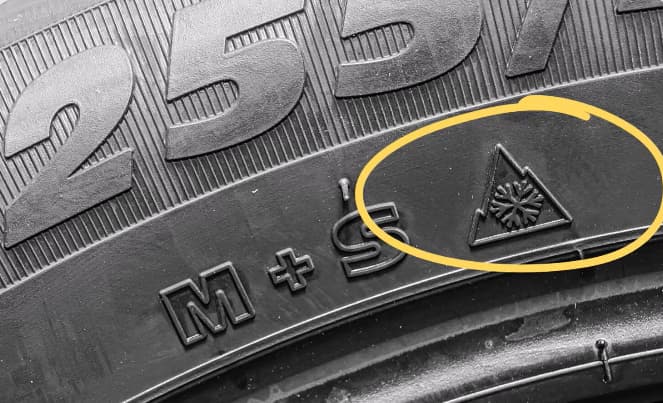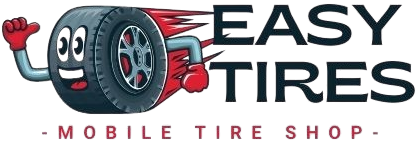ASK ANYTHING
Frequently Asked Questions
How do I know if my tires are underinflated or overinflated?
Finding the right tire size for your car is easier than it sounds! Here are a few reliable ways to do it:
Check Your Car Itself
- Driver’s side door jamb: Look for a sticker with recommended tire size, pressure, and load rating.
- Owner’s manual: It usually lists the original equipment (OE) tire size.
- Current tires: The sidewall of your tire has a code like P215/60R16—this tells you the width, aspect ratio, and rim diameter.
Which all services does easy tire provide?
Easytires is a professional mobile tire service that provides the following services at your doorstep
- New tire sales
- Seasonal changeover
- Seasonal swap
- Flat tire repair
- Quick tire repair
- Jump start
- Gas delivery
- Wheel balancing
- TPMS service
Do you sell new and used tires ?
Yes, Easy tires provides new tires for all vehicle types and across brands. We also have a select inventory of used tires. Please contact to get a quote.
What does mobile tire services mean?
Easy tires is a mobile tire shop that comes to you rather than you having to come to the shop. Want new tires for your car?
Just call us, we will give you the best quote and come to your home to install those tires too. No long waits at the tire shop anymore. Book an appointment now!
When is the right time to do seasonal changeover ?
The golden rule for seasonal tire changeover in Canada is when temperatures consistently stay above or below 7°C. Here’s how it breaks down:
Switching to Winter Tires
- When: Typically between October and November
- Why: All-season and summer tires lose grip below 7°C—even on dry roads
Switching to Summer or All-Season Tires
- When: Usually early to mid-April, once daily highs are consistently above 7°C
- Why: Winter tires wear out faster in warm weather and reduce fuel efficiency
Pro Tips
- Watch the forecast: Don’t rush the swap if there’s still a chance of frost or snow
- Use the 10-day rule: Wait until the average daily high is above 7°C for 10 consecutive days
- Store tires properly: Keep off-season tires in a cool, dry place away from sunlight
If you want help tracking the weather or picking the right tire type for your driving habits, We’ve got you covered.
What is the best time for tire rotation?
The best time to rotate your tires depends on your driving habits, vehicle type, and tire style—but here’s a solid rule of thumb:
General Recommendation
- Every 8,000 to 10,000 km (or 5,000 to 6,000 miles) is ideal for most vehicles
- Many drivers pair tire rotation with every other oil change for convenience
- If you drive aggressively or rack up high mileage, consider rotating more frequently
Seasonal Changeover = Perfect Opportunity
- In Canada, where you swap between winter and summer tires, use that moment to rotate them too
- This helps balance wear and keeps your tires performing evenly year-round
Why It Matters
- Promotes even tread wear
- Improves handling and braking
- Extends tire life
- Keeps your warranty valid with some manufacturers
If you’re noticing uneven wear or vibration, that’s a sign to rotate sooner. Want help figuring out the best rotation pattern for your car type? We can walk you through it!
What does the mountain/snowflake symbol mean on winter tires?

The mountain/snowflake symbol, officially known as the Three-Peak Mountain Snowflake (3PMSF), is a certification mark that tells you a tire is built for severe snow conditions.
What It Looks Like
- A snowflake inside a mountain with three peaks
- Found on the sidewall of winter and some all-weather tires
What It Means
- The tire has passed rigorous snow traction tests defined by the American Society for Testing and Materials (ASTM)
- It meets performance standards for acceleration on medium-packed snow
- Recognized by Transport Canada as a reliable indicator for winter driving safety
Not to Be Confused With…
- M+S (Mud and Snow): This label is based on tread design, not performance testing. It’s okay for light snow, but not certified for severe winter conditions
Why It Matters
- Tires with the 3PMSF symbol stay flexible in cold temperatures, improving grip and handling
- They’re often required in certain regions or mountain passes during winter
If you’re shopping for winter tires in Canada, this symbol is your best friend. Want help comparing some top-rated 3PMSF tires?
How do I read tire size and specifications?
Spotting underinflated or overinflated tires early can save you from poor handling, uneven wear, and even dangerous blowouts. Here’s how to tell the difference:
Signs of Underinflated Tires
- Tire looks slightly flat at the bottom, especially after sitting overnight
- Outer edges of the tread wear faster than the center
- Sluggish handling or delayed steering response
- Longer braking distances, especially in wet conditions
- Reduced fuel efficiency due to increased rolling resistance
- TPMS warning light may come on (if your car has it)
- Vibrations or wobbling at higher speeds
Signs of Overinflated Tires
- Center tread wears out faster than the edges
- Bumpy or harsh ride, especially over potholes or rough roads
- Reduced traction—less rubber touches the road
- Steering feels twitchy or overly sensitive
- Increased risk of blowouts, especially in hot weather or at high speeds
- Tires look overly rounded or bulging in the middle
Pro Tip: Use a Tire Pressure Gauge
- Check when tires are cold (before driving)
- Compare readings to the manufacturer’s recommended PSI (usually on the driver’s door jamb or in the owner’s manual)
- Adjust for seasonal temperature changes—pressure drops in cold weather and rises in heat
Want help finding the right PSI for your car or choosing a good pressure gauge? We’ve got some solid picks.
Do I need to balance my tires regularly?
Yes, balancing your tires periodically is a smart move for smoother rides, longer tire life, and better safety. Here’s the breakdown:
When Should You Balance Tires?
- When installing new tires or wheels
- Every 10,000 to 12,000 km (or every other rotation)
- If you feel vibrations in the steering wheel or floorboard
- After hitting a pothole or curb—even minor impacts can throw off balance
- When switching tires front-to-back or side-to-side during rotation
Why It Matters
- Prevents uneven tread wear and cupping
- Reduces vibration, especially at highway speeds
- Protects suspension components from stress
- Improves fuel efficiency and ride comfort
How It’s Done
- A technician uses a balancing machine to spin each tire and detect weight imbalances
- Counterweights are added to the rim to even things out
- Can be done with clip-on or adhesive weights, depending on your wheels
Pro Tip
If you’re doing a seasonal tire changeover, that’s a perfect time to balance them. And if you’re noticing vibrations or uneven wear, don’t wait—get them checked sooner.
Can I use all-weather tires year-round?
All-weather tires are designed for year-round use, making them a great option for Canadian drivers who want to skip the seasonal tire swap.
Why They Work Year-Round
- Temperature flexibility: They stay soft and grippy above and below 7°C, unlike all-season tires which stiffen in cold weather.
- Winter-ready: Most carry the Three-Peak Mountain Snowflake (3PMSF) symbol, meaning they’ve passed snow traction tests and are legally recognized for winter use in places like Quebec.
- Summer performance: While not as sporty as summer tires, they handle dry and wet roads well and resist wear in heat.
Ideal For:
- Urban drivers in cities like Toronto or Vancouver with mild winters
- Commuters who want one tire for all seasons
- SUV and crossover owners who need versatility without sacrificing safety
When They Might Fall Short
- In extreme winter conditions (deep snow, ice storms), dedicated winter tires still outperform all-weather options.
If you live in a region with heavy snowfall or mountainous terrain, you might want the extra grip of true winter tires.
Do I need a full set of winter tires or just two?
You definitely want a full set of four winter tires—and here’s why it’s not just about traction, but total control:
Why Four Is Better Than Two
- Balanced grip: Winter tires on all four wheels ensure consistent traction, braking, and cornering.
- Avoid fishtailing: If you only install two winter tires (especially on the front), the rear can lose grip and swing out—dangerous in icy turns.
- Stability: Uneven tire performance can confuse your car’s stability control and ABS systems.
- Legal requirements: In places like Quebec, four winter tires are mandatory during winter months.
What If You Only Use Two?
Experts strongly advise against it. But if you’re in a pinch:
- Put them on the rear axle, regardless of whether your car is front- or rear-wheel drive.
- This helps maintain control during braking and cornering, though it’s still not ideal.
Pro Tip
If budget is tight, consider all-weather tires with the 3PMSF symbol—they’re winter-certified and can be used year-round in milder climates like Vancouver.
Want help comparing full winter tire sets or finding budget-friendly options that still keep you safe? Call us.
How do I know when my tires need replacing?
Knowing when to replace your tires is all about spotting the signs before they become safety risks. Here’s a quick guide to help you stay ahead of the curve:
Visual Clues to Watch For
- Low tread depth: Use the quarter test—insert a quarter into the tread with George Washington’s head down. If you can see the top of his head, it’s time to start shopping.
- Tread wear bars: These are small horizontal bars molded into the grooves. If they’re flush with the tread, your tires are worn out.
- Cracks or bulges: Sidewall damage like cracks, cuts, or bubbles means the tire’s structural integrity is compromised.
- Uneven wear: If one part of the tire is more worn than others, it could signal misalignment or suspension issues.
Performance Red Flags
- Frequent air loss: If you’re constantly refilling your tires, they may have slow leaks or aging rubber.
- Vibration while driving: Could mean unbalanced or worn tires—or even internal damage.
- Poor traction: Slipping or sliding in wet conditions is a sign your tread isn’t doing its job.
Age Matters Too
- 5 years: Start inspecting annually, even if they look fine.
- 10 years: Replace them, no matter the tread depth—rubber degrades over time.
If you’d like help picking your next set, We can pull up top-rated options for your car and climate. Contact us.
What is TPMS (Tire Pressure Monitoring System)?
TPMS stands for Tire Pressure Monitoring System, and it’s your car’s built-in guardian for tire health and safety.
What It Does
- Monitors the air pressure in your tires in real time
- Alerts you via a dashboard warning light if any tire is significantly underinflated
- Helps prevent blowouts, poor handling, and reduced fuel efficiency
Two Main Types
- Direct TPMS
- Uses sensors inside each tire to measure pressure and sometimes temperature
- Sends data wirelessly to your car’s computer
- Offers precise readings for each tire
- Indirect TPMS
- Uses your car’s ABS wheel speed sensors
- Detects underinflation by noticing changes in wheel rotation speed
- Doesn’t measure pressure directly, so it’s less accurate but more affordable
What the Warning Light Means
- A yellow horseshoe-shaped icon with an exclamation mark
- Signals that one or more tires are 25% below recommended pressure
- May also flash if the system itself is malfunctioning
Maintenance Tips
- TPMS sensors can last 5–10 years, but batteries aren’t usually replaceable
- If you rotate tires or change wheels, the system may need recalibration
- Always check your spare tire—some vehicles include TPMS sensors in them too
Want help figuring out if your car uses direct or indirect TPMS, or how to reset it after a tire change? Contact us now.
Should I stick with the original equipment tires or upgrade?
Whether to stick with Original Equipment (OE) tires or upgrade depends on your driving style, priorities, and budget. Let’s break it down:
Why Stick With OE Tires
- Tailored performance: OE tires are engineered specifically for your car’s suspension, handling, and ride comfort.
- Consistent feel: They maintain the driving dynamics your car was tuned for at the factory.
- Warranty alignment: Some automakers recommend OE tires to preserve full warranty coverage.
- Fuel efficiency: OE tires often have low rolling resistance to help with mileage.
Why Consider Upgrading
- Better traction or comfort: Aftermarket tires may offer improved grip, quieter rides, or longer tread life.
- Seasonal or terrain needs: If you drive in snow, off-road, or want sportier handling, upgrades like winter or performance tires are worth it.
- Cost flexibility: Non-OE tires come in a wider price range, so you can find high-quality options that fit your budget.
- Newer tech: Some aftermarket tires feature innovations like run-flat capabilities or noise-reducing tread patterns.
Quick Comparison
Feature | OE Tires | Upgraded Tires |
Fit & Compatibility | Perfect match for your vehicle | May vary, but often customizable |
Ride Comfort | Tuned for factory suspension | Can be softer, stiffer, or quieter |
Performance | Balanced for general use | Tailored for sport, snow, or terrain |
Cost Range | Mid to high | Wide range, including budget picks |
Longevity | Moderate tread life | Some offer extended mileage |
If you love how your car drives now, OE tires are a safe bet. But if you want to tweak performance, comfort, or seasonal capability, upgrading could be a smart move. Want help comparing specific tire models for your car and climate? Call us.
Is it okay to mix different tire brands or types?
Mixing tire brands or types can be done, but it’s not ideal—and it comes with some important caveats. Here’s what you need to know before you roll with a mismatched set:
When Mixing Might Be Acceptable
- Same size and specs: If all tires match in size, load index, and speed rating, mixing brands is less risky.
- Same type: Stick to the same category—e.g., all-season with all-season. Don’t mix summer with winter or performance with touring.
- Same tread pattern: Mixing symmetric with asymmetric or directional tread designs can affect handling.
- Same axle: If you must mix, keep matching tires on the same axle (front or rear) to maintain balance.
Risks of Mixing Brands or Types
- Uneven wear: Different rubber compounds and tread designs wear at different rates.
- Inconsistent handling: Grip, braking, and cornering may vary between tires, especially in wet or snowy conditions.
- Reduced safety: Mismatched tires can confuse your car’s stability control and ABS systems.
- Warranty issues: Some manufacturers may void warranties if tires aren’t matched properly.
Pro Tips
- Avoid mixing run-flat with regular tires—they behave very differently.
- Don’t mix tire types for different seasons (e.g., winter with summer)—this can seriously compromise traction.
- Rotate regularly to help even out wear if you’re running a mixed set.
- Consult a tire pro if you’re unsure—especially for AWD or performance vehicles that are more sensitive to mismatches.
If you’re considering mixing brands to save money or due to availability, We can help you find compatible options that won’t compromise safety. Want to compare some budget-friendly tires that match your current setup? You know how to contact us!

